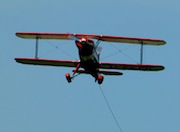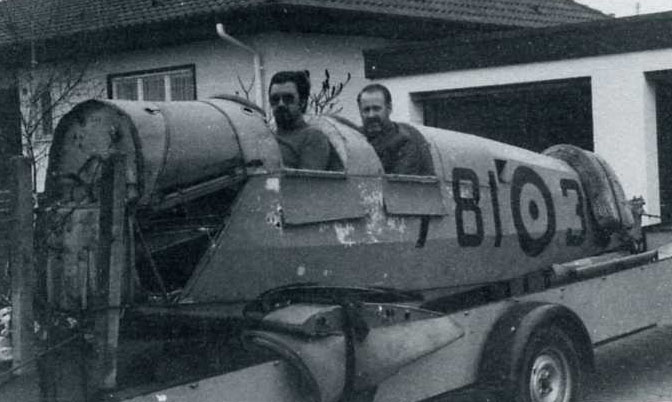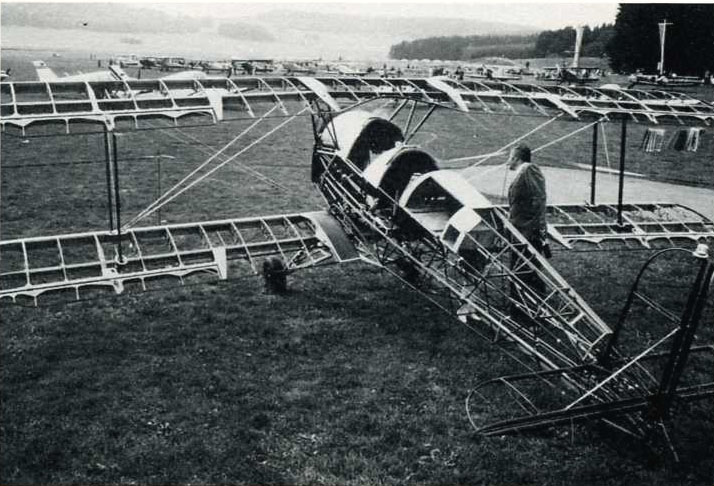 |
Year: ca 1950 Wingspan: 7.2m Power: 180 HP Max speed: 300 km/h Restored: 1980~1983 |
D-EEPK: Bucker Jungmann
For 25 years this red biplane has been based at the Mössinger mountain airfield of Farrenberg, situated about 50 km south of the Stuttgart airprort. This is the astonishing and exciting story of how the Bücker "PK" made its way to this place in the early eighties. The beginning of the "Bücker"
1934 – although the time of the biplane had been practically over in aeronautical history – Clemens Bücker designed the legendary Bücker 131 as a two seated trainer, sports- and aerobatic plane. Some time later he also designed the single seat Bücker 133, which had a more powerful engine and has been operated very successfully in aerobatic competitions for years.
The 131 was well designed and so became a successful commercial product, one of the most successful aircraft of its class built. More than 10.000 Bü 131 have been built worldwide – even in Japan Bückers were produced under license, and they were used a trainers for young pilots.
The last serial production took place in Spain in the 1960s. Bückers were built for the training of military and airline pilots. When this period ended the buckers were disassembled and stored in a hangar near Albacete.
When trash first came to Mössingen
1977 - This is when the story of D-EEPK begins. Sigi had contact with the Spanish war ministry and heard about the possibility of purchasing the Bücker planes (or what was left of them.) In July Sigi and Wolfgang Serwatzy flew down to Albacete in the club`s Remoqueur "HI", to inspect the aircraft.
Three months later at an auction Sigi bought one plane, complete down to the last bolt, but in „trash“ condition.

After undergoing unbelievable bureaucracy, the plane finally made its way to Germany on the trailer intended for the clubs Grob “Astir” glider. Some old guys at the airfield looked at the thing that was brought from Spain and said: “This thing will never fly again”!
Start of the restoration
Anyway, in 1980 Sigi began the restoration. After disassembling, all parts were cleaned and inspected by specialists from the German FAA. Many parts needed to be re-produced, then painted and sealed for the re-assembly of the plane.
This sounds simple but it was hard and time taking work. Many people at the airfield helped during this period of intense work on the plane. Many of them had the know-how to make this restoration project come true.
"Naked" in public
In 1982 the D-EEPK was presented to the public fort the first time, but not as it looks today. During a Bücker gathering at Degerfeld the plane was displayed, naked without fabric and without the engine. It was transported by truck, assembled there and put on display.
This was a sensation even for the Bücker specialists that gathered at Degerfeld because all planes displayed there were flying planes. One of the Bücker pilots offered an engine for sale, Sigi bought the engine and finally had all the parts needed to finish the project.

After the engine had arrived the team speeded up its work and in August 1983 the plane was finished It made its first flight at Farrenberg. Sigi was so nervous – but after a couple of minutes the LBA test pilot (German FAA) started with the first aerobatics over the field. Later joined by all the powered aircraft from Farrenberg, the Bücker was flown to Degerfeld airfield. The examiner said: “Looks fantastic and flies like a dream”.
Right after that he started training Sigi to fly his Bücker. When Sigi finished his training he flew whenever he had time and the weather cooperated.
An exciting flight 13
During his 13th flight Sigi had technical problems with the plane and he landed on a field that was used by RC planes. Sigi, with his long experience as a glider pilot managed to land the Bücker without a scratch, he said that „he was just lucky“……….
Fist time abroad
To fly all the way through Europe in an antique open cockpit biplane was something very special. The first tour lead back to the roots of the pane, to its mother country Spain. The controllers and pilots there were really amazed to see the beautifully restored Bücker and Sigi can tell a lot of stories about his trip.
During the approach to Valencia all commercial traffic up to Mirage-jets had to wait until the »Bücker Aleman« had landed safely on the 3000 meter runway. The Spanish officials insisted on housing the Bücker in one of their hangars.
Many flights over France, England, Austria and Italy made flying the Bücker a dream come true. The Bücker has also been used to tow gliders and banners.Its performance is outstanding even compared to modern planes. During her time at the Farrenberg the Jungmann flew for more than 700 hours.
At every airshow on nearby airfield the Jungmann is always present and does aerobatic displays. In this way, interested visitors may take part in the history of great aircraft that were designed and built many, many years ago. A lot of them have been inspired to work on vintage planes, learn about their history, some even started their own restoration projects.
We know that everyone that had the privilege to be invited to fly in a Bücker aricraft will never forget how good it feels. Their joy is our joy too.
Second restoration
From fall 2004 until April 2009 the PK was completely restored again. Since April 25, 2009 Sigi and his partner "Buddy" Heinz Peter are back in the air over Farrenberg and do their aerobatics over the Hohenzollern castle.
The white Bücker D-EEGN: Bü 131, C.A.S.A. 1.131E – Serie 2000
 |
Year: ca 1950 Wingspan: 7.2m Power: 120 HP Max speed: 300 km/h Restored: 19801 |
Since the early 1990 another Bücker Jungmann is in the air over Farrenberg. Gert Bender, a former motor cycle race champion, restored his Casa Bücker to perfection and became another member of the Bücker family.

